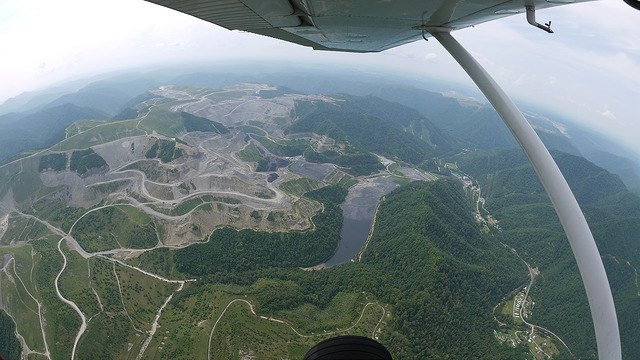“Get out of Missouri,” was the professional advice Tina Casagrand received as a young journalist fresh out of college. Instead, she hunkered down in a small city and started a print magazine for people who love the Lower Midwest just as much as she does.
Places matter to Tina Casagrand. So do journalism and culture. So do anthropology and science. So do readers, writers, books and magazines. And the Ozark mountains and the river basins of central Missouri. And other parts of the lower Midwest, too — places like Nebraska, Kansas, Oklahoma and Arkansas.
Casagrand is the founder and publisher of The New Territory, a reader-supported print magazine she created in 2015. In that role, she brings literary, anthropological, and ecological voices to a region that has challenges but ample optimism.

Casagrand launched the magazine about two years after graduating from the University of Missouri. With the talents of a small team of volunteers, the magazine puts its mission into practice, “to connect the land, people and possibilities of the Lower Midwest.” (The magazine has no digital version, but it does publish a blog, which occasionally includes a free sample article.)
Like many people living a creative, purpose–driven life, Casagrand didn’t start out knowing she wanted to be what she is now, although there were some early hints. She was raised by her great-grandparents in Dixon, Missouri, a town of about 1,500 southeast of the Lake of the Ozarks. She’d always loved to read, particularly magazines. In high school Casagrand didn’t realize that “magazine publisher” was a career path, but she worked on student publications and did other activities that suggested she might have a future involving the written word. She developed a strong interest in world culture and international travel. That led her to major in both journalism and anthropology. She minored in art, and then added another minor, biology.
Casagrand started freelancing in college, focusing on environmental writing. She was hungry to experience new cultures and places, to tell stories she discovered along the way. She “hit a high point early” in her freelance writing career when a story she wrote was published on the National Geographic website. It dealt with the epidemic of emerald ash borers killing trees and what could be done about it.
“That was cool and awesome, but along with the byline was the realization that I didn’t want to be doing that kind of work for very long,” Casagrand says. The problem was that so much context needed to be provided for a national story that there wasn’t much room for depth.
“I was in 1,200-word count hell,” she recalls. That’s when she came to terms with the fact that the outlet for what she wanted to do didn’t exist.
Instead of giving up, Casagrand saw an opportunity to both serve readers and improve the “writer ecosystem.” She wanted journalists to have a publication where they could pitch long, thoughtfully crafted stories with love for place at the forefront. She developed a prospectus for The New Territory and ran it past her peers in the Society for Environmental Journalists. They gave her encouragement and suggestions. Then she was ready to put out a “bat signal” that there was a location for in-depth narrative that would treat stories with care.
Casagrand now publishes The New Territory from her office in Jefferson City, Missouri’s capital. The editors, designers and others work remotely, scattered around the country. The magazine is distributed almost entirely through subscription and contains no advertising but does include a sponsorship section. This allows the bills to be paid, and the contributors, too. But the staff is all volunteer, including herself.
The New Territory just released its seventh issue, titled “Sanctuaries.” It includes stories about a Primitive Baptist Church in Arkansas that has seen years of declining membership; a farm family in the Ozarks that has expanded its activities to make ends meet; Native Americans and non-natives coming together to save a Kansas wetlands from highway construction; a photo essay on how Oklahomans are finding new ways to protect public lands as state park budgets erode; plus art, poetry and fiction.
Having lots of hands helping on the magazine allowed Casagrand to step away from daily editing duties. As publisher, she can focus on finding continued financial support. She sees convincing people to pay for quality journalism as a challenge that needs a solution. An added challenge is her location in the middle of Missouri, which is foreign ground to financial supporters that mostly cluster in the big cities. That’s why much of her effort is going into what she describes as “strengthening the friendships and partnerships we’ve made so far and telling more potential subscribers about the magazine.”
Casagrand is determined to stick to her focus creating an “autobiography of the lower Midwest,” even if not everyone is on board yet. She had numerous mentors in the journalism world who encouraged her to apply for opportunities around the country. One individual she barely knew told her that she’d never really be successful as a freelancer until she got out of Missouri.
“It was humiliating to be told this by an older person, but I couldn’t corroborate it. I didn’t think of myself as not being on track.” In what she calls a moment of clarity, Casagrand realized that versions of success are different, a viewpoint she conveyed to that person later the day.
It’s expected that people who are invested in her success might be a bit confused by her choices. In their experience, they see the best opportunities in bigger places. But Casagrand says she would “rather be rooted in a place” instead of having a “fragile existence” in a place she didn’t particularly wish to be.
Growing up she appreciated the natural beauty of the Missouri Ozarks but also took it for granted. When she went to college, she experienced different landscapes through travel and came to new ways to “process ideas about culture,” she says.
“If you’d told me at start of college I’d live in and love Missouri after graduation, I would have laughed you out the door. But it is beautiful and unique, and there aren’t a lot of journalists writing about the environment in Missouri. There is so much to cover you could make it a whole career, as a beat, and not touch everything.”
Still, it isn’t for everyone.
“There is high attrition of talented people leaving here, and I was on track to be one of them.” But she knew she had important and personally meaningful work to do. She paraphrases Senegalese forestry engineer Baba Dioum about caring for places and protecting them to make a healthy community. “You have to love it, but you can only love it by understanding it, and you can only understand it if you learn about it.”
She pictures readers of The New Territory as people who already love the Lower Midwest, care for it in their own way, and support regional journalism in myriad ways. “That’s who we sit down at our computers and make this magazine for,” Casagrand says. She and the team envision The New Territory being shared with people informally, and even formally in the classroom as teaching material guiding readers to understand the region better. “That why we imbue each issue with so much love.”
As Casagrand puts it, it’s true love, not just boosterism. “People see that it’s not fluffy content. An intelligent reader knows when they’re being sold something, and that’s one of the fastest ways to erode trust.”
Casagrand tells the life story of this state that is bounded by the Mississippi River on the east and partly bordered and bisected by the Missouri River. The rolling farmland of the north, the rugged and forested south, the flood plains of the southeast and the Great Plains to the west offer plenty to learn about and love.
Even the boundary between rural and urban spaces speaks to Casagrand. She carries a tangible emblem that reminds her of each, in the form of body art. On her left bicep is a tattoo of a whippoorwill, and on the right bicep is a blue jay. She calls the whippoorwill the “soundtrack of evenings sitting on the porch” in Dixon. The bird is sensitive to environmental conditions, such as habitat loss. “Even now when I hear one there’s an emotional homecoming sensation because it represents rural life for me.” On the other side is the blue jay, the adaptable and assertive bird whose constant energy and voice are an emblem of the comparatively urban life she’s leading now in Jefferson City. “The tattoos represent the balance I’ve found between contemplative focus and assertive action. In my ‘ideal’ world, nothing’s at the expense of the other.”
One of the things she’s realized is that being in an area some consider too remote to matter means Midwestern voices are left out of important national conversations. “What I wanted to do with The New Territory is have the freedom to talk to other Midwesterners about what’s important to us without having to filter our message for a national, largely urban and coastal audience and defend the mere right to be thought of as important.”
Magazine feature content has already been scheduled for two future issues, relying on local and regional voices who know the stories and how to tell them. They’re still open to accepting literature, photography, reviews, interviews and personal essays for the “Here” section.
One goal for 2019 is get into communities more, by designing events and workshops for the public to attend. The focus would be on writing and art, which could have the twin outcomes of increasing readership and building a larger freelance contributor pool. She’s also cooking up ideas about a traveling photography gallery that would be hung in different places in the region. Another project taking shape is a reading group series.
These ideas are enmeshed with other things she does, such as working with the group Missouri River Relief and serving on the Missouri Invasive Plant Task Force. Recently, she started as community manager at Campus Coworking Space, a new community-driven office space for people who would otherwise work from home.
“Most of this other work is centered around helping people find their place in the place that I know and care for,” she explained.
In an effort to encourage young Missourians, Casagrand teaches a three-week stint each June for the Missouri Scholars Academy, a program for gifted students. She teaches a nature writing class and a class called “Print Isn’t Dead.” Casagrand herself participated in this program as a high schooler. “That’s when I started to chill out about Missouri, and see how awesome it was to be surrounded by other smart people in the state and to broaden my horizons.”
Things do change. Casagrand’s great-grandfather passed away in 2016. But not before he caught sight of the bird tats. She’d tried hiding them because she guessed what his reaction would be, and it wouldn’t be good. But one hot Missouri day in the smoking area of the parking lot outside of the VA hospital where she waited with him, she couldn’t hide them under long sleeves any longer. “I took off my outer shirt and his mouth flew open, and he asked ‘Are those real?’”
Casagrand is working to keep them real both on the literal habitat level and the deeper emotional level. As she explains simply, “It would be a huge loss to the ecosystem if either was gone.”
Julianne Couch is a writer in Bellevue, Iowa. Her feature story on private property hunting as a form of rural economic development in Kansas will appear in The New Territory later this year.
This article was originally published by the Daily Yonder.



